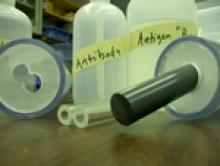
The goal of this demonstrate to visitors that antibodies help in preventing sickness by destroying antigens that enter the body.
The goal of this demonstrate to visitors that antibodies help in preventing sickness by destroying antigens that enter the body.
Materials needed:
Micro-scale
- Six test tubes
- Test tube rack
- 500mL squirt water bottle
- Borax Solution
- Acidic Solution (sprite?)
- Phenolphthalein
- Acidic Indicator (congo red?)
- 2 dropper bottles for indicators
- 2 500mL water bottles for solutions
- Disease name labels (for test tube rack)
- Paper towels
- Waste bucket
Macro-scale
- Plexi antibodies
- Antigen shapes
Procedure
Set-up:
- Fill 4 of the 6 test tubes with water, halfway. Fill test tube number 5 with borax solution. Fill test tube number 6 with acidic solution.
- Have paper towels, squeeze bottle of water and waste bucket available.
During the Presentation:
Micro-scale
- Discuss with the visitors what antibodies do in the body and how they help to prevent sickness.
- Explain that when a foreign substance enters a body, it is called an antigen.
Explain that the test tubes are filled with “fake” antigens that can get them sick (i.e. influenza, rabies, chicken pox, etc.). - Tell the audience that you have antibodies that match with one of the antigens in the test tubes.
- Have an audience member put 1-2 drops of the antibody (phenolphthalein) into each test tube and then ask the audience if they noticed any changes. The test tube containing the borax solution will turn bright pink.
- Explain to the audience that the antigen that turned pink (i.e. common cold), changed color because it matched the shape of the antibody.
- Have another audience member put 1-2 drops of another antibody (acid indicator) into each test tube and repeat steps 4-5.
Macro-scale
- Explain to the audience that the reason why the antigen and antibody matched is because they were similar in shapes.
- Have a volunteer make a “Y” by extender their arm out. Place a plexi tube antibody in each hand and ask them to pick up the corresponding antigen on the cart.
- Have another volunteer do the same demonstration, but with a different shaped antibody.
- Explain that only certain antibodies will match with certain antigens depending on the shape.
Clean-up:
- Pour contents of test tube into the waste bucket.
- Rinse the test tubes thoroughly with water before using again.
- Clean test tubes with soap and water 2-3 days a week.
Explanation:
Antigens are large molecules on the surface of cells, viruses, fungi, bacteria, as well as other substances that are considered foreign to the body. Your body recognizes antigens as a threat to health and produces antibodies that attempt to destroy the antigen.
Scientists create vaccines to help you from getting sick. Vaccines contain antigens that are very weak, but won’t make you sick. Your body recognizes these antigens and starts making antibodies to help protect your body. So if you do get a particular virus or bacteria, you body will be prepared to kill the antigen with the antibodies that have been created from the vaccine. (i.e. chicken pox vaccination).
Procedure Sheet: antibodies_procedure.pdf
Antibodies FAQs
A antigen is a foreign agent that infects a person or animal and causes them to become sick. Antigens can be virus or bacteria Our bodies fight antigens with proteins called antibodies. Antibodies stop the antigens from infecting other cells in our bodies by locking on the the virus and killing it.
Cool Facts
- Viruses are not alive, they need a host (a person or animal) to reproduce.
- Your body has a library of antibodies, it remembers every antibodies it makes!!
- You can only be infected by the same antigen once. This is why you will only get the chicken pox once!!!!
- When we are infected by a virus or certain types of bacteria our bodies produce many different antibodies, but only one will help us to get better!!
A: An antibody looks like a Y, it is made up two chains a heavy chain and a light chain. The heavy chain looks like a Y and the light chain is located along the top part of the Y that spreads out.
A: Antibodies are specific to each antigen, just like a lock and a key. At the top of each antibody is an area called the variable region, this region is different for each antibody and is specific for fighting each different type of antigen. When you get a cold, a virus, your body looks through its antibodies to see if any of them are the proper key used to kill the cold virus. If you do not have the right “key” you body makes new antibodies to fight the antigen. Hopefully your body will produce the right key quickly!!
A: A flu shot contains a small amount of inactive flu virus. Your body does not know that the virus is inactive and begins to produce antibodies against that strain of flu. If you catch the flu your body already has the antibody meaning you will not get sick.
A: When our bodies produce antibodies they are very specific to each virus or bacteria. Each year the influenza virus that gives us the flu is slightly different meaning we need new antibodies specific to that strain of the virus to keep us healthy.
Anyone who ever had the flu or gets a common cold knows that antigens such as viruses impact our lives. While there is no cure for a those viruses we have found ways to stop the spread of more dangerous antigens, like polio and small pox, which used to cause many people to die. We have made vaccines that you receive when you are young that help you produce antibodies that will protect you from those antigens.

